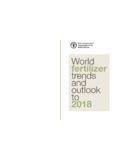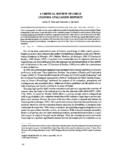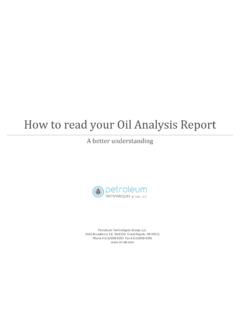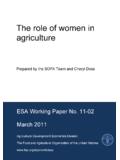Transcription of The State of Food Insecurity in the World
1 2015. The State of food Insecurity in the World Meeting the 2015. international hunger targets: taking stock of uneven progress Cover photo: FAO/Seyllou Diallo FAO information products are available on the FAO website ( ). and can be purchased through Key messages J About 795 million people are undernourished western Africa, south-eastern Asia and globally, down 167 million over the last South America, undernourishment declined decade, and 216 million less than in faster than the rate for child underweight, 1990 92. The decline is more pronounced suggesting room for improving the quality of in developing regions, despite signi cant diets, hygiene conditions and access to clean population growth. In recent years, progress water, particularly for poorer population has been hindered by slower and less groups. inclusive economic growth as well as political instability in some developing regions, J Economic growth is a key success factor such as Central Africa and western Asia.
2 For reducing undernourishment, but it has to be inclusive and provide opportunities J The year 2015 marks the end of the for improving the livelihoods of the poor. monitoring period for the Millennium Enhancing the productivity and incomes of Development Goal targets. For the smallholder family farmers is key to progress. developing regions as a whole, the share of undernourished people in the total J Social protection systems have been critical population has decreased from percent in fostering progress towards the MDG 1. in 1990 92 to per cent. Some regions, hunger and poverty targets in a number such as Latin America, the east and south- of developing countries. Social protection eastern regions of Asia, the Caucasus and directly contributes to the reduction of Central Asia, and the northern and western poverty, hunger and malnutrition by regions of Africa have made fast progress.
3 Promoting income security and access to Progress was also recorded in southern Asia, better nutrition, health care and education. Oceania, the Caribbean and southern and By improving human capacities and mitigating eastern Africa, but at too slow a pace to reach the impacts of shocks, social protection fosters the MDG 1c target of halving the proportion the ability of the poor to participate in growth of the chronically undernourished. through better access to employment. J A total of 72 developing countries out of 129, J In many countries that have failed to reach or more than half the countries monitored, the international hunger targets, natural and have reached the MDG 1c hunger target. human-induced disasters or political instability Most enjoyed stable political conditions have resulted in protracted crises with and economic growth, often accompanied increased vulnerability and food Insecurity of by social protection policies targeted at large parts of the population.
4 In such contexts, vulnerable population groups. measures to protect vulnerable population groups and improve livelihoods have been J For the developing regions as a whole, the difficult to implement or ineffective. two indicators of MDG 1c the prevalence of undernourishment and the proportion of underweight children under 5 years of age . have both declined. In some regions, including 2015. The State of food Insecurity in the World Meeting the 2015. international hunger targets: taking stock of uneven progress food AND AGRICULTURE ORGANIZATION OF THE UNITED NATIONS. Rome, 2015. Required citation: FAO, IFAD and WFP. 2015. The State of food Insecurity in the World 2015. Meeting the 2015 international hunger targets: taking stock of uneven progress. Rome, FAO. The designations employed and the presentation of material in this information product do not imply the expression of any opinion whatsoever on the part of the food and Agriculture Organization of the United Nations (FAO), the International Fund for Agricultural Development (IFAD) or of the World food Programme (WFP) concerning the legal or development status of any country, territory, city or area or of its authorities, or concerning the delimitation of its frontiers or boundaries.
5 The mention of specific companies or products of manufacturers, whether or not these have been patented, does not imply that these have been endorsed or recommended by FAO, IFAD or WFP in preference to others of a similar nature that are not mentioned. The designations employed and the presentation of material in the maps do not imply the expression of any opinion whatsoever on the part of FAO, IFAD or WFP concerning the legal or constitutional status of any country, territory or sea area, or concerning the delimitation of frontiers. ISBN 978-92-5-108785-5. FAO encourages the use, reproduction and dissemination of material in this information product. Except where otherwise indicated, material may be copied, downloaded and printed for private study, research and teaching purposes, or for use in non-commercial products or services, provided that appropriate acknowledgement of FAO as the source and copyright holder is given and that FAO's endorsement of users' views, products or services is not implied in any way.
6 All requests for translation and adaptation rights, and for resale and other commercial use rights should be made via or addressed to FAO information products are available on the FAO website ( ). and can be purchased through FAO 2015. C O N T E N T S. 4 Foreword 6 Acknowledgements 8 Undernourishment around the World in 2015. 8 The global trends 10 Wide differences persist among regions 17 Key findings 19 Inside the hunger target: comparing trends in undernourishment and underweight in children 19 Regional patterns 25 Key findings 26 food security and nutrition: the drivers of change 27 Economic growth and progress towards food security and nutrition targets 31 The contribution of family farming and smallholder agriculture to food security 33 International trade and food security linkages 35 The relevance of social protection for hunger trends between 1990 and 2015.
7 37 Protracted crises and hunger 42 Key findings 44 Technical annex 44 Annex 1: Prevalence of undernourishment and progress towards the World food Summit (WFS) and the Millennium Development Goal (MDG) targets in developing regions 48 Annex 2: Methodology for assessing food security and progress towards the international hunger targets 53 Annex 3: Glossary of selected terms used in the report 54 Notes T. F O R E W O R D. his year s annual State of food Insecurity in the World report takes stock of progress made towards achieving the internationally established hunger targets, and reflects on what needs to be done, as we transition to the new post-2015 Sustainable Development Agenda. United Nations member states have made two major commitments to tackle World hunger. The first was at the World food Summit (WFS), in Rome in 1996, when 182 governments committed.
8 To eradicate hunger in all countries, with an immediate view to reducing the number of undernourished people to half their present level no later than 2015 . The second was the formulation of the First Millennium Development Goal (MDG 1), established in 2000 by the United Nations members, which includes among its targets cutting by half the proportion of people who suffer from hunger by 2015 . In this report, we review progress made since 1990 for every country and region as well as for the World as a whole. First, the good news: overall, the commitment to halve the percentage of hungry people, that is, to reach the MDG 1c target, has been almost met at the global level. More importantly, 72 of the 129 countries monitored for progress have reached the MDG target, 29 of which have also reached the more ambitious WFS goal by at least halving the number of undernourished people in their populations.
9 Marked differences in progress occur not only among individual countries, but also across regions and subregions. The prevalence of hunger has been reduced rapidly in Central, Eastern and South-Eastern Asia as well as in Latin America; in Northern Africa, a low level has been maintained throughout the MDG and WFS monitoring periods. Other regions, including the Caribbean, Oceania and Western Asia, saw some overall progress, but at a slower pace. In two regions, Southern Asia and sub-Saharan Africa, progress has been slow overall, despite many success stories at country and subregional levels. In many countries that have achieved modest progress, factors such as war, civil unrest and the displacement of refugees have often frustrated efforts to reduce hunger, sometimes even raising the ranks of the hungry. Progress towards the MDG 1c target, however, is assessed not only by measuring undernourishment, or hunger, but also by a second indicator the prevalence of underweight children under five years of age.
10 Progress for the two indicators was similar, but slightly faster in the case of undernourishment. While both indicators have moved in parallel for the World as a whole, they diverge significantly at the regional level owing to the different determinants of child underweight. Overall progress notwithstanding, hunger remains an everyday challenge for almost 795 million people worldwide, including 780 million in the developing regions. Hence, hunger eradication should remain a key commitment of decision-makers at all levels. In this year's State of food Insecurity of the World , we not only estimate the progress already achieved, but also identify remaining problems, and offer recommendations for how these can be addressed. In a nutshell, there is no one-size-fits-all solution. Interventions must be tailored to conditions, including food availability and access, as well as longer-term development prospects.














